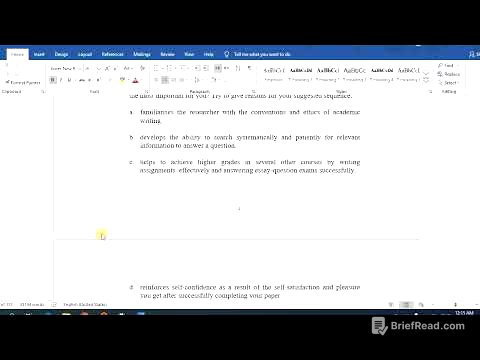TLDR;
This YouTube video is a comprehensive history lesson, focusing on key periods and figures in Indian history. It covers the Indus Valley Civilization, Vedic Culture, Buddhism, Jainism, the Maurya and Gupta Dynasties, Harshvardhan, and the early Muslim invasions. The lecture emphasizes important facts, timelines, and cultural aspects, providing a detailed revision for students.
- Indus Valley Civilization and Vedic Culture
- Buddhism and Jainism
- Maurya and Gupta Dynasties
- Harshvardhan and Muslim Invasions
Intro [2:03]
The instructor welcomes the students, emphasizing the importance of the class as a semi-final for their history studies. He encourages them to stay focused and revise effectively, promising a comprehensive overview of Indian history.
Syllabus Discussion [4:03]
The instructor outlines the syllabus for the history class, which includes the Indus Valley Civilization, Vedic culture, Gautam Buddha, Jainism, the Maurya dynasty (specifically Emperor Ashoka), the Gupta dynasty (Chandragupta II), Harshvardhan, the Rajput period, the Delhi Sultanate, the Mughal Empire, the Maratha Empire, British rule, the 1857 revolt, and various social and religious reform movements. The syllabus also covers the early years of the independence movement, revolutionary movements, and key figures like Netaji Subhash Chandra Bose.
Indus Valley Civilization [6:44]
The discussion begins with the Indus Valley Civilization, also known as the Harappan civilization or the Bronze Age civilization. Bronze was a key metal used during this period, with copper being the first metal invented by humans, followed by bronze and then iron. The initial discovery of the civilization is credited to Charles Mason in 1826, with further surveys by Cunningham in 1856. The Archaeological Survey Department of India was formed in 1861 due to Cunningham's efforts.
Time Period and Key Sites [11:30]
The Indus Valley Civilization flourished on the banks of the Indus River. John Marshall dated it from 3250 to 2750 BC, but a more accepted range is 2750 to 1750 BC or 2500 to 1750 BC. In 2014, the oldest city of this civilization, Bhadana in Haryana, was discovered, dating back approximately 7520 BC, making it about 9,500 years old. The civilization was urban, with well-developed cities. The southernmost point was Daimabad in Maharashtra, the easternmost was Alamgirpur near Meerut in Uttar Pradesh, the northernmost was Manda in Jammu and Kashmir, and the westernmost was Sutkagendor in Pakistan. The civilization spanned 13 lakh square kilometers.
City Structure and Script [20:01]
The Indus Valley Civilization's cities were divided into two mounds: a western mound for the upper class and an eastern mound for the lower class. Dholavira was unique, having three tiles with a middle mound for protectors. The script, pictographic and written from right to left, remains undeciphered. The people worshipped Pashupati Devta, and society was cooperative. The civilization's shape was triangular, and the humped bull was considered sacred.
Occupation, Metals, and Harappa [25:31]
The primary occupation was business, with trade connections to Arab. Bronze was the main metal used. Harappa was discovered in 1921 by Daya Ram Sahni on the banks of the Ravi River. Key features included a 5-kilometer perimeter, grid-patterned cities, evidence of burial, and cotton cultivation. The security fort was named "Mount AB" by Wheeler.
Mohenjo-daro and Chanhudaro [39:36]
Mohenjo-daro, discovered in 1922 by Rakhal Das Banerjee on the banks of the Indus River, means "killer of the dead." It featured a huge granary (45 by 15 meters) and a large bathhouse (18.8 by 7.01 by 2.4 meters) with stairs on both the north and south sides. Swastika symbols and woven cloth evidence were found here, along with a statue of a dancing girl made of bronze. Chanhudaro was a manufacturing center for beads, with curved bricks and footprints of a dog chasing a cat. Makeup items and cosmetics were also found here.
Lothal, Kalibanga and Dholavira [47:15]
Lothal, located on the banks of the Saffron River in Gujarat, was a commercial town with a dockyard (Godiwada) and evidence of horse bones. Kalibanga in Rajasthan, on the banks of the Ghaggar River, featured ploughed fields made of wood and evidence of bangles. Raw bricks were used for houses, while baked bricks were used in Mohenjo-daro. Dholavira revealed a water management system and evidence of a tsunami.
Decline of Indus Valley Civilization [53:19]
The Indus Valley Civilization declined due to various reasons, including invasions and climate change. The most accepted theory is natural disasters.
Vedic Civilization: Introduction and Origins [54:37]
The Vedic civilization is associated with the composition of the Vedas. The Aryans, who were not native to India, migrated from outside. Iron was a key metal used during this period, facilitating agriculture. The Vedic civilization is divided into the pre-Vedic (1500-1000 BC) and post-Vedic (1000-600 BC) periods. The Rigveda is the oldest of the four Vedas and was composed during the pre-Vedic era.
Aryan Origins and Society [59:49]
The Aryans referred to their system as "gave birth to this system". Max Muller believed they came from Central Asia, while others suggested the Pamir rocks, Tibet, Hungary, or the North Pole. Tilak ji suggested North Pole based on descriptions in the Rig Veda. The Aryans defeated the existing people in India, who became known as "Anarya."
Vedic Society and Rigvedic Features [1:05:57]
Aryan society was structured with the nation as the largest unit, composed of Vish, Jain, and Gram. The head of the nation was the king. The Rigvedic period was characterized by a society that consumed both vegetarian and non-vegetarian food, with the cow considered sacred. Important food items included Yuvangu (barley), Dhana (desert), and Somras (a sacred tree).
Rigveda and Later Vedic Period [1:14:02]
Indra was the most beloved god, mentioned 250 times in the Rigveda. The Sindhu River was mentioned 55 times, while the Ganga was mentioned only once. The Saraswati River was considered the most sacred. The society was developed and modern, with no child marriages or purdah system. The caste system was based on karma, not birth. The Rigveda contains 1028 branches, with the Gayatri Mantra in the third mandal and the caste system in the tenth mandal.
Four Vedas and Brahmin Texts [1:18:26]
The four Vedas are Rigveda, Yajurveda, Samveda, and Atharvaveda. The Rigveda is the oldest, while the Atharvaveda is the newest. The Samveda is about music, with 1875 mantras. The Yajurveda describes Yagya rituals, and the Atharvaveda tells about witchcraft and magic. Brahmin texts were written to simplify the Vedas.
Vedangas, Ramayana, and Mahabharata [1:33:26]
The six Vedangas are education, grammar, Kalpa, astrology, Nirukta, and Chhand. The Ramayana was written by Valmiki in Sanskrit, with later versions adding interesting events. The Mahabharata was written by Ved Vyas. There are 18 Puranas, with the oldest being the Matsya Purana. There are 108 Upanishads, with 13 being the main ones.
Upanishads and Social Structure [1:43:17]
The largest Upanishad is the Vrihadaranyak Upanishad, and the shortest is the Mandukya Upanishad. The Mundak Upanishad contains the phrase "Satyamev Jayate." The four ashrams (celibacy, household, exile, and sanyaas) are mentioned in the Jwala Upanishad. There were eight types of marriages, but now only love and arranged marriages remain.
Buddhism: Gautam Buddha and Key Facts [1:50:14]
Gautam Buddha, born in 563 BC and died in 483 BC, is known as the "Light of Asia." His childhood name was Siddhartha, his father was Suddodan, his mother was Mahamaya, his wife was Yashodhara, and his son was Rahul. He left home at 29, an event called "Mahabhneshkramana," and attained knowledge at 35 under a Peepal tree on Baisakh Purnima in Bodhgaya.
Buddha's Teachings and Key Events [1:58:57]
Buddha's first sermon was given in Sarnath to five brahmins, an event called "Dharma Chakra Pravartan." He allowed women into the Buddhist nun community in Vaishali on Anand's advice. The four Aryan truths are that the entire human race is suffering, there is a reason for suffering, there is a solution to suffering, and the Eightfold Path is the way to solve it.
Buddhist Symbols and Literature [2:09:46]
Key symbols include the lotus (birth), bull (youth), horse (planetary renunciation), Peepal tree (knowledge), wheel (first sermon), and footprints (salvation). Buddhist literature includes the Tripitaka (Sutpatak, Vinaypitaka, and Abhidhammapitaka). The Sutpatak is called the "Encyclopedia of Buddhist Religion." The Triratna in Buddhism are Buddha, Dham, and Sangha.
Buddhist Councils and Key Figures [2:17:02]
There have been four historically important Buddhist councils. The fourth council, during Kanishka's time, divided Buddhism into Mahayana and Hiniyana. Key figures include Mahakashyap, Mogli, Vasu friend, and Ashwaghosh. Buddha's gurus were Alr, Rudrak Ram, and Jupiter.
Buddhism vs. Jainism and Key Differences [2:24:36]
Buddhism follows the middle path to attain knowledge, while Jainism emphasizes hard penance. Buddhism does not have a caste system, while Jainism does. Buddhists do not believe in the soul, while Jains do.
Jainism: Founders and Tirthankaras [2:29:22]
The founder of Jainism is Rishabhdev, with Mahavir Swami being the real founder. There have been 24 Tirthankaras. The book Kalpasutra, written by Bhadrabahu, tells about them. Key Tirthankaras include Rishabhdev (Taurus symbol), Ajit Nath (elephant symbol), Parshvanath (snake symbol), and Mahavir Swami.
Parshvanath and Mahavir Swami [2:36:52]
Parshvanath, the 23rd Tirthankara, was born in Varanasi and gave four anuvratas: never steal, never lie, non-violence, and not accumulating wealth. Mahavir Swami added the fifth rule: celibacy.
Mahavir Swami: Birth and Teachings [2:39:48]
Mahavir Swami was born in 540 BC and died in 468 BC. His father was Siddhartha, his mother was Trishala, and his childhood name was Vardhaman. His wife was Yashoda, and his daughter was Anuja Priyadarshini. He left home at 30 and attained knowledge at 42.
Jain Concepts and Literature [2:48:07]
Key Jain concepts include Triratna (correct sight, correct knowledge, and correct conduct) and Kevalya (attaining knowledge). Jain literature is called Agam, with 12 Angas. The most sacred text for Digambara is Shatkhandagam.
Jain Sects and Councils [2:51:55]
The two branches of Jainism are Shwetambara (wear white clothes) and Digambara (directions as clothes). The first Jain Council was held in 320 BC in Pataliputra, and the second was in 512 AD in Vallabhi.
Maurya Dynasty: Introduction and Key Rulers [2:56:00]
The Maurya dynasty ruled Magadha. Chandragupta Maurya, with the help of Chanakya, founded the dynasty. Key rulers include Chandragupta Maurya, Bindusara, and Emperor Ashoka.
Emperor Ashoka: Early Life and Inscriptions [3:00:06]
Emperor Ashoka ascended the throne in 269 BC. His mother's name was Mahadevi. Key inscriptions include the Masha record, Uday Golan record, and Gurjar record. He called himself the emperor of Magadha in the Bhavru inscription. The GT Feller discovered Ashoka's inscriptions, and James Princep read them.
Ashoka's Inscriptions and Kalinga War [3:06:29]
Ashoka's inscriptions were in Brahmi script in India, Kharosthi in Pakistan, and Greek in Asia Miner. He was impressed by his wife, Mahadevi. The Kalinga War, fought in 261 BC, led to Ashoka's conversion to Buddhism.
Ashoka's Dhamma and Successors [3:11:40]
Ashoka promoted Dhamma, emphasizing self-control and public welfare. He sent his son Mahendra and daughter Sanghamitra to propagate Buddhism. He built stupas, including the Sanchi stupa. The last ruler of the Maurya dynasty was Brihadrath.
Gupta Dynasty: Founders and Key Rulers [3:24:01]
The Gupta dynasty's founder was Shree Gupta, with Chandragupta I becoming the real ruler in 319 AD. Samudragupta, known as the "Napoleon of India," followed Chandragupta I.
Samudragupta and Chandragupta II [3:29:49]
Samudragupta's mother was Kumar Devi, and his wife was Datta Devi. He followed the policies of "Eclipse Moksha" and "Annexation." His victories are mentioned in the Prayag Prashant article, written in Sanskrit by Harisena. Chandragupta II came to the throne in 380 AD.
Chandragupta II and Navratnas [3:39:21]
Chandragupta II's title was Vikramanka and Vikramaditya. He had Navratnas (nine gems) in his court, including Kalidas, Varah Mihir, and Dhanvantari. Fa-Hien visited India during his reign from 399 to 414 AD.
Harshvardhan Dynasty: Origins and Key Figures [3:52:35]
The Pushyabhuti dynasty of Thaneshwar was founded by Pushyabhuti, also known as Narvardhan. Prabhakar Vardhan was Harshvardhan's father, and Rajyashri was his sister. Harshvardhan conquered North India, with Kannauj as the center.
Harshvardhan's Reign and Xuanzang's Visit [4:00:01]
Harshvardhan was defeated by Pulakeshin II in 618 AD. Xuanzang visited India during his reign from 630 to 645 AD. Harshvardhan wrote three plays: Ratnavali, Nagananda, and Priyadarshika. Banbhatta wrote Harsh Charit.
Harshvardhan's Contributions and Early Muslim Invasions [4:07:30]
Harshvardhan started the Kumbh Mela and Maha Moksha Parishad. The lecture transitions to the early Muslim invasions, starting with the Arabs.
Arab Invasions and Muhammad bin Qasim [4:11:27]
The first Arab invasion failed in 711 AD, but Muhammad bin Qasim successfully invaded Sindh in 712 AD. He imposed the Jaziya tax on non-Muslims. The book Chachnama, written by Ali Ahmed, provides information about this period.
Ghaznavid Invasions and Mahmud Ghaznavi [4:16:49]
Subuktgin unsuccessfully tried to invade India. Mahmud Ghaznavi, known as "Murti nephew," launched 17 attacks on India. His 16th attack in 1025 AD targeted the Somnath Temple.
Alberuni, Firdausi, and Ghori [4:22:03]
Alberuni wrote Kitab ul Hind, and Firdausi wrote Sahana. Muhammad Ghori attacked India in 1175 AD.
Battles of Tarain and Chandavar [4:24:50]
In 1191 AD, Prithviraj Chauhan defeated Ghori in the first battle of Tarain. However, Ghori won the second battle of Tarain in 1192 AD. In 1194 AD, Ghori defeated Jaichand in the battle of Chandavar.
Sufism and Qutb-ud-din Aibak [4:30:34]
Moinuddin Chishti promoted Sufism in Ajmer. Ghori issued coins with Goddess Lakshmi and Nandi. He started the unity tradition, giving soldiers land instead of salary. In 1206 AD, Ghori was killed in Pakistan.









